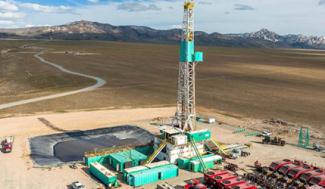The Utah FORGE research team, with NETL support and oversight, recently surpassed a significant milestone in its ongoing work to develop an enhanced geothermal system (EGS) that will flow hot water naturally from a subsurface depth of more than 10,000 feet and bring it to the surface.
Once the clean energy technology is optimized and developed, EGS could power tens of millions of American homes and businesses and help the nation meet its net-zero carbon emission goals in the power sector by 2035 and the broader economy by 2050.
Geothermal resources occur where water circulates through a network of interconnected fractures, or pathways, within naturally hot rocks found deep below the planet’s surface. Operators can then produce power from the hot water once it is brought to the surface by deep underground wells.
Located near the town of Milford on the western flank of the Mineral Mountains, the U.S. Department of Energy-sponsored Utah Frontier Observatory for Research in Geothermal Energy, also known as Utah FORGE, was the site for a 10-day stimulation trial in April.
During the three stages of testing, between 3,000 and 4,000 barrels of water were injected under pressure to well depths exceeding 10,000 feet, causing pre-existing fractures in the reservoir to dilate and transfer heat to the injected cold water. The hot injected water was produced back to the surface under controlled flow conditions.
“The stimulation trial ran according to schedule and plan. These results are significant because they advance the development of geothermal resources around the world as a clean energy source,” said Scott Beautz, an NETL petroleum engineer who is managing the Utah FORGE project in collaboration with partners with the Energy & Geoscience Institute at the University of Utah and the U.S. Department of Energy Office of Energy Efficiency & Renewable Energy’s Geothermal Technologies Office.
The ability to initiate, propagate and ideally control hydraulic fracture growth is essential for realistically evaluating the potential for commercial EGS applications. Meeting these goals also promotes technical and hybrid EGS methods that use hydraulic injection to provide a heat exchange network or to achieve more effective connections with potentially productive natural fractures.
NETL’s involvement with Utah FORGE has contributed the Lab’s world-class knowledge and experience gained in oil and gas operations to the expanding geothermal industry to usher in a new era of environmentally friendly resource extraction and use.
“NETL is applying its horizontal drilling and hydraulic fracturing knowledge from the oil and gas industry to EGS research. By doing so, EGS plants can play a vital role in America’s clean energy transition by providing baseload power around the clock regardless of weather conditions and with the flexibility to meet consumer demand,” Beautz said.
The total measured depth of the well in the April stimulation trial reached 10,987 feet. In late 2022 or early 2023, a second deep deviated well, the production well, will be drilled to a planned total measured depth of 10,697 feet to intersect the hydraulic fractures at the Utah FORGE project site. The connectivity of the fractures between the two wells will be established or improved, and short-term circulation testing will begin to assess the thermal viability geothermal reservoir.
Utah FORGE began operations in 2015 and will continue through 2025. Additional project work is focused on optimizing drilling, simulation techniques, flow testing and subsurface imaging technologies required to establish and sustain continuous fluid flow and energy transfer from an EGS reservoir.
NETL is a U.S. Department of Energy national laboratory that drives innovation and delivers technological solutions for an environmentally sustainable and prosperous energy future. By leveraging its world-class talent and research facilities, NETL is ensuring affordable, abundant and reliable energy that drives a robust economy and national security, while developing technologies to manage carbon across the full life cycle, enabling environmental sustainability for all Americans.




